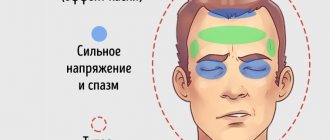Neuroses are a general name for a group of human mental disorders to which everyone is susceptible to one degree or another. For the most part, they are caused by prolonged experiences, traumatic events in life, and severe stressful situations.
Neurosis is the result of an unresolved conflict between desires and reality. They interfere with normal living, work and development, greatly deplete the nervous system, and increase anxiety. The body begins to respond to the problem accordingly. All sorts of psychosomatic disorders appear.
The usual treatment method in such cases is psychotherapy. But if during therapeutic conversations it is not possible to establish and eliminate the causes of disorders, since they lie in the sphere of the unconscious, then there is every reason to treat neuroses with the help of hypnosis.
When treating neurosis-like conditions, both classical hypnosis with rigid settings and Ericksonian (permissive) hypnosis are used. This soft form of suggestion integrates positive healing ideas and ideas into the psyche, but not through direct persuasion, but unobtrusively affects consciousness. Today it is preferred in most cases as a more effective and completely safe procedure for the patient.
Modern therapeutic hypnosis is a kind of connecting link between consciousness and subconscious, which opens the way to the hidden energetic and spiritual potential of the person himself. It allows you to find out what was the trigger for the development of neurosis, reduces the intensity of symptoms or completely eliminates them. The results of therapy last for a long time.
This is especially important if the disorder is associated with deep-seated internal conflicts or chronic psycho-emotional stress, and also if it takes a protracted course. Conventional methods may not give the desired effect. Then hypnosis is the saving treatment method that normalizes mental processes and allows you to solve the problem of neurosis.
Features of hypnosis for neurosis
Before conducting a hypnotic session, the client’s goals are clarified, symptoms are diagnosed, trust is established with the patient, and the level of his hypnotizability is assessed. There are certain hypnosis techniques. The hypnotherapist selects a method depending on the problem that he intends to solve and the personal characteristics of the patient.
Let's consider the most common and proven methods of hypnotic influence.
To immerse oneself in a trance, as a rule, auxiliary objects or sounds are used. The choice of subject does not matter. The therapist uses anything that helps distract attention: a pendulum, a ticking clock, metronome beats, calm music. Instead of using sight or hearing, the hypnotherapist may use techniques to influence the senses of smell or touch. For example, lightly stroking the skin also helps to immerse oneself in a trance.
The duration of the session is individual. The time spent depends on the speed of the patient’s immersion in a trance, the complexity of the problem and the changes in the psyche that have occurred.
Hypnotherapy can help solve many psychological, emotional, and in some cases physical problems. Hypnosis is effective in treating thermoneurosis, psoriasis, obsessive-compulsive disorders, addictions, phobias, panic attacks, and depression.
Of course, individual hypnotherapy with direct contact with a hypnotherapist is much more effective. But you can try hypnosis for nerves on yourself without visiting a specialist. You can listen to hypnosis for neurosis in a recording. For example, those suffering from phobic disorders and panic attacks can try hypnosis for stress and anxiety listen online
When treating neurasthenia, it is useful to listen to a hypnosis session for depression online. After all, the cause of neurasthenia is often prolonged depression, which leads to depletion of the body’s nervous system.
Hypnosis is worth trying, if only because the trance state itself is healing. Neurotic disorders are characterized by increased muscle tone. Hypnotherapy promotes muscle relaxation, which brings tangible relief to the patient.
propanika.ru
Obsessive-compulsive disorder: causes
At the moment, the exact etiological reasons for the formation of obsessive-compulsive disorder have not been established. Scientists put forward several reasonable hypotheses about the origin of this pathology.
Among the existing versions, the most proven hypothesis is the assumption that the leading cause of the disorder is congenital defects in the structures of the brain and acquired pathological defects in the functioning of the autonomic nervous system. Another likely cause of the development of OCD is a malfunction in neurotransmitter systems: lack of production, disturbances in the metabolism of serotonin, dopamine, norepinephrine and gamma-aminobutyric acid can provoke the appearance of obsessions and compulsions. Scientists suggest that the tendency to OCD may be passed from ancestors to descendants as a result of unusual mutations in the hSERT and SLC1A1 genes. One of the modern versions of the origin of obsessive-compulsive syndrome is the theory of PANDAS syndrome, the essence of which boils down to the negative impact of infectious agents on the mental sphere of the body.
However, the above factors act only as a basis that predisposes to the formation of an anomaly, and are not the reason leading to disruptions in the human psyche. Often the real culprit of OCD is hidden beyond understanding: the cause of the disorder cannot be determined by the efforts of the person's will. Since the meaning of performing compulsive actions comes down to carrying out activities aimed at avoiding a collision with the object of fear, it can be assumed that the true cause of the pathology is a psychotraumatic situation that occurred in a person’s life and was erased from memory into the deep parts of the psyche - the subconscious.
It has also been found that the first episodes of obsessive-compulsive disorder are often recorded in people who are under intense stress. The sudden death of a loved one, a break in a relationship with a regular partner, an unexpected change in social status or financial situation trigger stress reactions, which in some people develop into psychopathological defects.
Research shows that OCD patients have a similar psychological profile. These are suspicious, impressionable, vulnerable and anxious people. They exaggerate their own responsibility for what is happening. They tend to weigh everything carefully and think for a long time about the reasons for certain events. They overestimate the likelihood of danger. Many OCD sufferers believe in the materiality of thoughts. The overwhelming number of individuals who have been diagnosed with obsessive-compulsive disorder are distinguished by pedantry and perfectionism. They strive to do everything perfectly and leave no room for error.
Neurosis and hypnosis
Neuroses - reversible changes in the psyche, such as obsessions, hysterical reactions, panic reactions and phobias are successfully treated with hypnotherapy or, simply put, hypnosis. Some division between classical directive hypnosis takes place, and gives a confrontation of methods and specialists of psychotherapists and psychologists. The article provides basic concepts and also attempts to reconcile these techniques, since in psychotherapy both classical directive hypnosis and “soft” Ericksonian hypnosis are successfully used to treat neuroses. Neurotic manifestations also include chronic fatigue and neurasthenia, which grow violently due to the discrepancy between a person’s vital needs and his capabilities provided by the environment and society.
Is it possible to get rid of this problem?
Obsessive thoughts or ideas that arise literally begin to haunt you, and the more effort it takes to free yourself from them, to distract yourself from obsessive thoughts, the brighter, stronger and more intrusive the thoughts become.
Over time, thought begins to put more and more pressure on a person and encourage him to perform certain actions. Without specialized help, not only thoughts, but also actions will become obsessive, violent and threatening. Such self-destructive thoughts include obsessive thoughts about suicide, which can subsequently drive a person to suicide.
Intrusive thoughts can concern the future, present or past. The plots can be either realistically projected (I will definitely be attacked from around the corner if I walk too close) or fictional (the earth will burst and we will all fly into space, or what will happen if all the water flows out of the tap). Irrational obsessive thoughts about health can push a person to actions that threaten not only his life, but also the lives of loved ones. These include obsessive thoughts about infidelity.
Sometimes a thought arises as a desire, and not as an image, for example, there is an uncontrollable desire to count objects or rub your hands before grasping the door handle. As the obsessive thought progresses, it can prompt equally irrational actions (storing and regularly replenishing a year’s supply of water in the house) or develop fears and rituals (fear of going out because you will have to turn a corner or turn only after going out into the middle of the road). Obsessive-compulsive syndrome develops.
If a thought appears that is as annoying as a fly and cannot be gotten rid of, you should not decide on your own how to treat obsessive thoughts; it is better to immediately consult a psychologist. Don't wait for obsessive thoughts to take over your mind, because the longer they haunt you, the harder it will be to free yourself from them.
What is neurosis and what are its manifestations?
Before we talk about the features of treating neurosis, let's look at what it is. So, neurosis is a reversible borderline mental disorder that is caused by life traumatic factors, as well as conscious of the client
and occurring directly without disrupting the perception of the real world.
Some, unfortunately, do not attach much importance to such disorders and simply believe that neurotic conditions will go away on their own. But it is not so. The sooner we address the problem, the better for each of us.
The main signs of neuroses
What are the main signs of neuroses? This:
• Significant fatigue and rapid decline in quality of life;
• Mental exhaustion, which can lead to the most negative consequences;
• Development of phobias, as well as feelings of fear and anxiety;
• The presence of various vegetative disorders - vegetative means vital, biological manifestations that are not directly related to the psyche, but psychosomatics as a branch of psychotherapy shows an indirect connection between these manifestations of the body and the psyche;
• Pain in the abdomen, also heart pain and headaches;
• Sharp loss of appetite.
If the patient exhibits most of the listed symptoms, then the doctor can diagnose him with neurosis.
Nowadays, real classical hypnosis
. There are various techniques that can quickly bring a person out of a neurotic state, as well as restore the will to live and good mood.
Let's call the main stages of ridding a patient of neuroses hypnosis. This:
• Preliminary diagnosis of symptoms, as well as initial consultation and competent choice of treatment methods;
• Prevention of neuroses, which is aimed at preventing all relapses of this condition.
So, through the so-called “point of contact,” an experienced hypnotherapist provides a person with certain specific information, which he then perceives in ordinary life as a specific guide to active action. These are certain specific sentences or words. In addition, depending on the patient’s condition, the hypnotist individually selects the most proven and reliable classical techniques.
Unlike the everyday idea of hypnosis - to completely erase or change everything that is required in the memory, the medical approach requires leaving the memory of a traumatic experience in the mind, but changing the attitude towards it, giving resourcefulness - after all, the event was experienced, giving meaning.
Causes
All people sometimes experience intrusive thoughts; this may be due to a life situation or emotional state. They play the role of a kind of psychological protection from a stressful situation. In a state where a person cannot psychologically cope with circumstances, the brain simply switches consciousness to secondary thoughts, hiding traumatic thoughts deep in the mind.
Normally, after the situation is resolved and the person’s emotions return to normal, the obsessive thought that appears gradually fades into the background and completely disappears. Low self-esteem and self-doubt can provoke the development of obsessive thoughts. Even if a person knows how to overcome obsessive thoughts, it is difficult for such a person to free himself from them.
Often, intrusive thoughts are sexual in nature (for example, intrusive thoughts about infidelity). By denying one’s own sexuality, suppressing sexual desires, driving oneself into strict boundaries, a person puts himself in a position where the brain is looking for a way to escape from the intrapersonal conflict.
The brain is forced to compensate for the rejected reality with fictitious images. A similar situation arises when sexual impulses are subject to constant conscious or unconscious doubt and analysis. As a result of the internal struggle, vital energy is depleted, powerlessness arises, a feeling of exhaustion occurs, and there is simply no strength left to take action.
Protecting itself from such psychological conflicts, the brain switches and uses obsessive thoughts as a compromise between subconscious taboos and unconscious desires. To resolve an internal psychological conflict, it is necessary to bring the unconscious into the realm of the conscious, become aware of your desires and learn to live with them.
Intrusive thoughts in children
A child may develop obsessive thoughts for many reasons. Children may be haunted by obsessive thoughts about the death of loved ones, about harming them or themselves, etc. Psychological help in childhood gives good results, the child will learn how to escape from obsessive thoughts, and a psychotherapist will help get rid of problems in the future.
Rules for immersion in hypnosis for neurotic conditions
So, usually the patient is asked to fix his gaze directly on a certain luminous point; the hypnotherapist can also speak in a calm and monotonous voice, and sometimes uses light music or a certain set of words.
Afterwards the client falls into a trance and the therapy session begins. There is no specific dive time. The duration of sessions is also set individually. For example, if a person is already experiencing quite serious mental changes, then, undoubtedly, a specialist can prescribe several sessions at once.
By using the widest possibilities of modern psychotherapeutic techniques in a competent combination directly with hypnosis-trance, you can achieve excellent results in the near future. Psychotherapy with hypnosis
– relatively fast. This helps the client to read and process the information stored in the unconscious regarding his mental trauma, and also helps to find the optimal solution, quickly optimize all the processes that occur in the body and approach healing.
Help from a psychotherapist
Help from a practical psychologist in Yekaterinburg. During the sessions, the psychologist will advise you on how to get rid of obsessive thoughts and fears, you will have the opportunity to understand the root of the problem, find the source of the intrapersonal conflict that caused the appearance of obsessive thoughts. Psychotherapy helps you understand your own thoughts and feelings, accept yourself along with your unconscious desires, realize your sexuality and learn to manage it.
During the sessions you will receive an answer to the question: “How to get rid of obsessive thoughts and fears?” Call and sign up for a consultation!
Basic principles, methods, and methods of hypnosis successfully used in the treatment of neurosis
So, there are certain methods, principles, and also techniques of hypnosis. It is not worth talking directly about which of the listed options is better and more effective until the hypnotherapist works with the client and has chosen the appropriate option. For example, proper distraction of consciousness, also penetration into the subconscious, influencing the client. The most common and proven options are methods such as:
• Adjustments - the hypnotherapist, observing the client, copies the rhythm of his speech or movement - facial expressions, gestures - this is how a trusting connection is established;
• Anchors - key moments in memories, in reality “here and now” - what is the reference point for memory, the switch of the script, to which a new, healthy way of adaptation is attached;
• Natural trance - a person in everyday life falls into a trance spontaneously - this is the need of an organism that has consciousness. The hypnotherapist notices and applies these natural physiological states of the client;
• Through commanding words - a lot has been written about non-directive hypnosis, new hypnosis, NLP, unlike new techniques, classical hypnosis involves precisely the influence that will be beneficial for the client. These techniques are justified for quickly working with traumatic experiences and for overcoming pathological beliefs;
• Various built-in messages and other techniques.
It should be remembered that any hypnosis is a fairly powerful technique and you should only contact a competent specialist. By using it correctly, you can reliably work with obsessional neuroses and conversion disorders.
Healing from obsessive thoughts
Nick 04.12.2013
Noosphere
How can a person get rid of obsessive ideas and thought forms? What can the Higher Teachers advise on this matter? Thank you in advance for your reply and best wishes for your further progress.
Informational response from the Teachers of the Noosphere with the transfer of the technology necessary for the people of Earth to get rid of obsessive thoughts and thought forms: People believe that thought does not have important manifestations in their lives and therefore they are not picky when accepting thoughts. But it is from correctly accepted thoughts that everything constructive and creative is born. Thought is the guide on which your direction on the path and the development of your inner Essence depend.
You suffer from your obsessive thoughts, they stick to you and cling to you, as they try to become for you the only clue in life that you must rely on.
You need to fight obsessive thoughts in which false ideas come to you, trying to take power over you. your consciousness is constantly attacked by such ideas and cannot focus on the main thing, on that essential constant that is inherent in you. The active onslaught of obsessive empty thoughts reduces the quality of your life and prevents you from developing in the right direction.
Because of these thoughts, it is difficult for you to concentrate on the main thing, try not to become dependent and under the power of such thoughts.
You are obliged to soberly assess the situation, make true plans and implement them correctly and accurately.
Since your head is constantly teeming with extraneous thoughts, it is difficult for you to focus on the right path and find the reserves within yourself to overcome problems and move towards the truth. This perception often leads to a dead end, and you perceive reality incorrectly.
You should live only with positive and constructive thoughts. You need to tune your consciousness every minute, and with the power of consciousness you need to drive away uninvited guests.
Everything in your life is just beginning, the people around you and your loved ones love you, only light, joy, perfection awaits you ahead, you have a meaning in life - this is your development and improvement. These are the thoughts you should merge with every second.
Thoughts that you are not perfect and fulfilled enough should not permeate your consciousness. There is no need to feel sorry for yourself because of your painful sensations in the body, accept it as a necessary and temporary manifestation. Don't create a crisis within yourself. There is no need to start a storm in a teacup. You suffer only from personal attitudes that are directed deep into an incorrectly constructed concept.
Your mind is completely clogged with garbage from your thoughts. Therefore, you do not feel stability in the future, in the correctness of your actions, in the correct perception of yourself as a high-quality and complete unit.
Obsessive thoughts are vampires for you. Which suck the energy you need. Wrong thoughts lead to absurd actions and actions that are completely out of character for you.
These thoughts control your behavior, communication with other people, take away your sense of life and do not allow you to get out of a state of constant dissatisfaction.
Such thoughts act like viruses and are always dangerous. They completely determine your behavior and attitude towards life.
Your thoughts do not carry any underlying mental illness, but are a monotonous repetition of your doubts, fears, desires, memories, and actions. It is difficult to get rid of such thoughts with one effort of will. In your thoughts, the real problem is magnified, distorted and feared.
Don’t try to get rid of such thoughts by force; this will deplete your consciousness, weaken it, and cause even more viral thoughts. This leads to depression, painful thoughts, fear and anxiety.
Obsessive thoughts affect your Consciousness and this is their strength. These thoughts are imposed on you from the outside, so Consciousness is not able to control this process. You understand that your thoughts are not logical, but you cannot control the process of organizing them.
To help your mind control your thoughts, you should analyze them and ask yourself questions: “How did I think of this?”, “Where did this thought come from?”, “How did this thought get into my head?”, “Why doesn’t this thought seem stranger to me? You need to help your consciousness with the power of constructive thought and the purity of bright reflection and awareness to get rid of obsessive thoughts.
These thoughts are sent by an independent mind that exists in parallel. The destructive energies of these parallel existing Essences destroy you, since you yourself let them into yourself. Their main weapon is to mislead your thinking and direct you along a destructive path of development. You've probably noticed that there are no constructive obsessive thoughts, and all thoughts are aimed at doubt, destruction and depression.
To get rid of obsessive thoughts, you should clearly understand that all these thoughts are not yours, that they are viruses and are imposed by destructive components. These negative energies stick to you quickly and strongly, since you yourself do not analyze the absurdity of thoughts and do not even put into them the beginnings of doubt that this may be wrong.
By analyzing your thoughts, you will understand which thoughts deprive you of peace and a sense of satisfaction. If from any thoughts and actions you have negative sensations in the 4th chakra and above, you feel chills or heat, or fuss appears inside, then this is not your thought. This means your valuable essence, soul, consciousness does not want to accept these thoughts and actions. Refuse them immediately, without putting them off for later, just drive them away and forget.
All obsessive thoughts support your despair, disbelief, pessimism, addictions, fears. Drive away all spiritual viruses from yourself. Overcome the internal resistance that often arises when you deny them. Pray, get baptized, read the Bible, meditate. This will distract you from obsessive thoughts and prevent them from taking root in your mind and influencing your soul.
“I don’t understand what I’m doing: because I don’t do what I want, but what I hate, I do... I don’t do the good that I want, but I do the evil that I don’t want... But if I do what I don’t want, I already It is not I who do it, but sin that dwells in me.”
Obsessive thoughts take root in your emotional sphere. You have little control over this, because she is hurt by you. You have a well-developed consciousness, so you are able to cope with this problem and you can and must restrain your emotions with logic, reason and consciousness. Logical thinking predominates in you, so it is easier for you to resist the emotions that overwhelm you.
Give up self-pity, inertia towards others, apathy, despair and depression. All these indicators multiply the manifestation of obsessive thoughts.
Consciousness is your home and letting everyone in indiscriminately is dangerous. Don't open the door of your soul to all thoughts. After the attack of such thoughts, signs of the experienced catastrophe remain in the soul.
You can protect yourself from such thoughts only if you know your enemies by sight and use self-defense means. Only people who are highly spiritual and progressing in development can do this. You can do it. Do not let obsessive thoughts into yourself, do not have an internal conversation with them.
“A thought, like a thief, comes to you - and you open the door for him, bring him into the house, start a conversation with him, and then he robs you. Is it possible to start conversations with the enemy? Not only are they avoiding conversations with him, but the door is also tightly locked so that he does not enter.”
Try to do yoga, meditate for 30 minutes a day, don’t be lazy, this is good for relieving muscle activity, which flares up sharply during periods of your crises. This will help you relieve muscle tension, relax your body, reduce anxiety, and relieve fears. And it will reduce the intensity of obsessive thoughts.
Do relaxation exercises several times a day, this will help you get rid of obsessive thoughts: lie down, relax your body as much as possible, mentally transport yourself to some beautiful place, nature. Start by relaxing the muscles of your face, then relax the muscles of your neck, shoulders, torso, and complete this process with your fingers and toes. Imagine that every muscle in your body is completely relaxed. Feel it. If you were unable to relax any part of the body or muscle group, then try to tense them as much as possible and then relax. Do this several times, and the desired muscle group will definitely relax. You should be in a state of complete relaxation for 15 to 30 minutes.
To completely get rid of obsessive thoughts, you need to recognize their presence and the need to get rid of them.
You must take responsibility, only you are responsible for the consequences and actions that occur under the influence of obsessive thoughts. But you should not consider obsessive thoughts your own. Pay attention to all the contradictions between your interests, your logic and those thoughts that are trying to take over you. Assess their inappropriateness, inconsistency, consequences and unprofitability of the actions that following these thoughts may lead to. Ponder this. Think about whether you see in these thoughts a direct discrepancy with what your consciousness tells you.
Recognize that these thoughts are not yours, that they are the result of an external attack of other entities on you. As long as you consider obsessive thoughts to be your own, you will not be able to oppose them with anything and take measures to neutralize them. You cannot neutralize yourself. Don't get into an argument with obsessive thoughts. If they appear, try to switch your attention, do not conduct internal dialogues with them.
Obsessive thoughts have one feature: the more you resist them, the more forcefully they attack. The more you tell yourself that you can handle it, the less you can handle it.
This condition cannot be overcome by willpower alone. You should simply switch your attention from obsessive thoughts to something else (more pleasant), without coming into conflict with the obsessions themselves. As soon as you switch your attention and begin to ignore obsessions, they lose their power for a while. The more often you ignore them, the less they bother you.
It is better to switch your attention to what helps you. Prayer, reading your favorite books, work, creativity, any favorite activity.
Obsessive thoughts act like energy leeches. They are forced to feed off your emotions in order to move on with their lives. It is emotions and imagination in this case that will feed these parasites. So try not to react to these thoughts. Counter them with logic every time. Don't become a slave to your obsessive thoughts.
If you are doing something, then never ask yourself the question: What if? You will always succeed, everything will turn out the way you want it.
Do not practice self-hypnosis by repeating obsessive thoughts to yourself. Complain less about how bad you feel, that you have nothing to live for, that nothing is working out for you. This gives you a feeling of helplessness. The more often you repeat these negative attitudes, the more negatively they affect your thoughts, feelings, sensations, emotions, and consciousness.
Throughout the day, repeat the same thing, without “no”. I am healthy, full of strength and energy, I feel good, I am fully realized, I want to live. I will bring a lot of benefit to the Earth and people. Let us set ourselves only to a positive and creative beginning.
The most powerful weapon against obsessive thoughts is prayer.
God is stronger than the Devil, so your prayerful appeal to him will definitely help you. You need to pray consciously, putting all your strength and energy into this action.
If the essence of your obsessive thoughts is an unwillingness to accept circumstances, despair, then the essence of the prayer should be humility: “God’s will be done!”
If the essence of obsessive thoughts is despondency, despair (and this is a consequence of pride), a grateful prayer will help here - “Thank God for everything!”
If you are tormented by anger at someone, then simply pray for him: “Lord, bless him!”
You need to pray continuously, until victory, until the invasion of thoughts stops, and peace and joy reign in your soul.
← Previous post
Next entry →
How to deal with criticism of classical hypnosis
Hypnosis in various forms has been used since time immemorial, when there was no medicine; all religious and shamanic rituals contain hypnotic rituals. The difference in the use of hypnosis by a physician is that the hypnotherapist takes responsibility for the patient.
If we approach psychotherapy as a purely Western invention, based on the philosophy of existentialism and the values of freedom and separation, then classical hypnosis is under attack, its methods are criticized - since the patient is not free to choose, some desired behavior is imposed on him. But if you look deeper, choice appears if a person is aware of at least two behavior options, reaction options. It often happens that there are no options in the client's experience other than pathological reactions. By installing (I’m specifically using a computer metaphor) some ways of reacting, the hypnotherapist gives a chance to choose from something.
Whether traumatic experiences persist after hypnotic sessions is an important question. The experience will remain; medical hypnosis is not intended to “erase” anything important. This type of therapy does not work as crudely as electroshock (ECT), which has become a thing of history, but as a result, a different attitude towards painful episodes appears, new frames and ways of reacting that the client could not apply in life - he simply never experienced them, did not experienced before.
If the reader is aware of the differences between classical and modern hypnosis (non-directive, Ericksonian, named after the inventor of the method), then most likely he has not experienced the method itself, has not been subjected to classical hypnosis, and has not worked with a therapist who uses Ericksonian hypnosis techniques. The differences in methods are significant, but the principle of influence remains. Along with the use of hypnosis to change traumatic experiences, it can be used to relieve anxiety and stress disorders. If we assume that this is an alternative to the use of medications, then it is a good one - since hypnosis, unlike psychoactive substances, has no side effects.
www.granatmc.ru
ethnoscience
Obsessive-compulsive disorder
Obsessive-compulsive neurosis is a rare type of neurosis, which is considered one of the most intractable forms of neurosis.
Symptoms of obsessive-compulsive neurosis : patients have obsessive fears and thoughts, fears, doubts, thoughts, memories, movements and actions (tics, etc.), various pathological fears (phobias).
The most common obsessive fear of heart disease (cardiophobia), fear of enclosed spaces (claustrophobia), or open spaces (agrophobia), general fear (pantophobia), fear of being ridiculed in public (erythrophobia), fear of physical disability (dysmorphophobia), fear of pollution ( mesophobia), fear of death (thanatophobia), fear of being buried alive (taphephobia).
More rare manifestations of the disease are obsessions, memories of movements or actions (rituals).
Obsessive-compulsive neurosis is most observed in people of the thinking type or with anxious and suspicious character traits, also in psychopathy.
Obsessive-compulsive neurosis is usually called obsessive neurosis, and phobia is classified as a special form of neurosis.
The cause of obsessive-compulsive neurosis : mental trauma (including conflict situations generated by the coexistence of contradictory tendencies). An example would be a feeling of hatred towards a loved one, a desire for his death.
Obsessive states can occur both with neurasthenia and psychasthenia, but in some cases they are an independent symptom complex.
Obsessive-compulsive neurosis is divided into three types of conditions:
- obsessive thoughts (obsessions): obsessive thoughts, reflections, memories, doubts that arise in people who are soft, indecisive, anxious, unsure of themselves, prone to constant hesitation and doubt. The patient is critical of his condition, he understands its meaninglessness and absurdity, but cannot get rid of it. With obsessive doubts, a person is haunted by thoughts about whether they acted correctly in a given situation, whether their decision was correct, whether everything was done as it should be. Obsessive thoughts manifest themselves in the fact that the patient repeats to himself the same phrase or thought, while at the same time realizing their absurdity.
Less common are obsessive desires to steal some thing, even unnecessary ones (kleptomania), an attraction to deception (michomania) and other deviations.
There are also contrasting obsessions - when a person has two conflicting desires. Such obsessions are characterized by a feeling of alienation, an absolute lack of motivation for such desires.
- obsessive fears (phobias): claustraphobia - fear of closed spaces, agorophobia - on the contrary, fear of open spaces; Cardiophobia – fear of getting an incurable heart disease; oxyphobia - fear of sharp objects, etc. (fear of death, fear of heights, loneliness, small animals, shaking hands or touching doors (“so as not to get infected”)... The appearance of phobias is accompanied by vegetative symptoms: pallor or redness of the face, dry mouth, sweating , heartbeat, dilated pupils, etc.
In many patients, obsessive states grow based on real, but significantly exaggerated fears. For example, after the death of a close relative from a cancerous tumor, a person begins to look for signs of the disease in himself. At the same time, there appears unfounded concern about the imaginary symptoms of a serious illness, which causes the formation of senestopathic and hypochondriacal disorders.
Attacks of fear can be accompanied by various autonomic disorders: tachycardia, sweating, pale face, etc.
Obsessive fears may arise for no reason or their strength and nature do not correspond to the situation. For example, a misfortune or unpleasant event has long passed, but the feeling of its reality and the associated fear remain constant. Sometimes patients try to get rid of their fears with the help of certain rituals.
- movements, actions (impulses). During obsessive actions, the patient makes some stereotypical movement, touches an object with his hand, coughs, winks, grimaces.
Obsessive actions are stereotypical, repetitive, seemingly aimless actions, which often have the appearance of a ritual. There are four main types of such actions:
- cleansing (most often washing hands and wiping surrounding objects);
- actions related to clothing: dressing in a special sequence, endless straightening of clothes;
- counting (often in the form of listing objects and out loud).
Treatment of obsessive-compulsive neurosis at the developmental stage is to remove the factor that caused the disease. If this cannot be achieved, psychoanalysis must be performed.
An effective method is complex treatment, combining psychotherapy methods, relaxation exercises and medications that normalize serotonin metabolism. The task of rational psychotherapy comes down to the education of the volitional process. It is necessary to achieve conscious regulation by the patient of his actions. Work with a psychasthenic should follow “two paths: clarification and activation.”
In most cases, hypnosis for obsessive-compulsive disorder can provide a significant therapeutic effect. The treatment of obsessive-compulsive neurosis by hypnotic suggestion was first used by V. M. Bekhterev (1892). It was the successful use of hypnosis in a number of obsessive states that showed that they are not degenerative and constitutional manifestations. Even before this (1890), V. M. Bekhterev reported a severe case of obsessions, which ended in recovery thanks to treatment with self-hypnosis.
If the sensory component is highly expressed, M. S. Lebedinsky and T. L. Bortnik recommend autogenic training, and E. K. Yakovleva recommends pathogenetic psychotherapy.
For phobias, the method of motivated suggestion (in hypnosis) according to K. I. Platonov and the method of reproductive experiences by M. M. Asatiani can be used - reproducing in hypnosis the situation of the formation and pathological fixation of phobias and their active extinguishing (the primary fear reaction, which formed the basis obsessive fear).
Patients are prescribed a strict work regime, tourism, sports, and gymnastics.
Source: Traditional medicine Obsessive-compulsive neurosis Obsessive-compulsive neurosis is a rare type of neurosis, which is considered one of the most intractable forms of neurosis. Symptoms of obsessive neurosis https://www.prirodlekar.ru/archives/2627
Treatment of neuroses with hypnosis
Clinic Doctor SAN uses the method of hypnosis in the treatment of neuroses. Reversible psychogenic disorders that arise against the background of external or internal factors and require long-term treatment are called neuroses. The easiest way to get rid of them is hypnosis. Effective treatment of neuroses with hypnosis is based on identifying the causes of the disease and eliminating them.
The danger of neurosis lies in the fact that it affects all areas of the patient’s activity. A person suffering from neurosis unconsciously perceives the reality around him through the prism of these problems. It causes:
When treating with hypnosis, methods of persuasion, encouragement and suggestion are provided, the result of which is aimed at distracting the patient from the significance of the pathological process. During treatment, irritating factors are rethought, and concentration on their significance weakens. The patient, with the help of a hypnologist, adapts to life outside the events that caused the neurosis.
Our psychotherapists select an individual course for each patient, which depends on the duration of the illness and the patient’s personal qualities. Sometimes patients come to us with severe forms of neurological disorders that last for years.
Diagnosis and treatment
The main diagnostic tool for an experienced psychotherapist is a conversation with the patient. Clinical tests and modern medical equipment are ineffective in identifying neurotic disorders. These measures only help to exclude other pathological processes. The identification of the psychotraumatic factor and a comprehensive assessment of the patient’s personality come to the fore.
Treatment of neuroses is carried out in different ways. Anchor. The choice of a specific technique and the construction of a treatment regimen begins after identifying the causes of the development of a pathological mental state. Drug treatment is used in extreme cases that require restoration of certain physiological processes in the central nervous system.
cognitive therapy. Many experts believe that the patient’s independent construction of a picture of his personality will help cope with mental disorders of a neurotic nature. The psychotherapist helps the neurasthenic understand the relationship between life experience and the situation that led to the development of the disease. During the classes, the patient’s personality undergoes some changes, allowing him to subsequently cope with traumatic situations without mental impairment;
color therapy. Psychotherapists have long noticed that different colors can cause different reactions in the brain. Immersing a neurasthenic in a certain color environment allows one to achieve positive results in the treatment of the disease. The color red causes aggression and anger; to extinguish these emotions, you should avoid all shades of red in your environment.
music therapy. The principle of this method is quite simple. First you need to choose a melody that matches your mood at the moment. Then the patient is asked to listen to a musical composition that can neutralize the effect of the first. It is important to select works that are light and airy. The third melody should be more confident and dynamic, demonstrating will and courage. Treatment of neurasthenics with music was practiced by many famous psychiatrists, including Bekhterev;
exercise stress. Swimming, aerobics, athletics, and brisk walking stimulate the cardiac system, saturate the blood with oxygen and lift your mood. The loads should be feasible, carried out 4-5 times a week for about 15 minutes; gastronomic method. Carbohydrates found in sweets and chocolate have been proven to have a calming effect.
During treatment, different methods can be used. Under the guidance of a psychotherapist, the patient must learn to use various techniques independently.
It is impossible to completely exclude the occurrence of new stressful situations or repetition of traumatic events in the future, but after a course of psychotherapy the body will not react to them with neurasthenia.
Hypnosis for neurosis
Doctors at our clinic, who treat neuroses with hypnosis in St. Petersburg, influence the patient’s subconscious using the hypnosis method, laying down the necessary information. This information subsequently encourages the patient to reconsider his attitude towards the events that caused psychological trauma. Phrases are developed and selected very carefully. Their meaning is maximally aimed at eliminating a specific cause, taking into account the severity of the patient’s condition.
The hypnosis method does not aim to rid the patient of unpleasant memories. All events preceding a neurotic disorder remain in memory, but the attitude towards them changes. Carefully selected meaningful phrases of our psychotherapists convey positive attitudes, eliminate negativity, and force a person’s psyche to restructure. Positive attitudes make it possible to look at the situation differently, mitigate the stress experienced, and form a new attitude towards past events.
Only hypnosis for neurosis can restore strength on a physical and emotional level. As a result of hypnotherapy sessions, internal reserves are activated, aimed at fighting the disease. Our psychotherapists successfully cope with advanced stages of neurotic disorders that last for years. The problem is neutralized, and the patient gains peace of mind.
After the hypnotherapy sessions, when the patient is freed from the heavy burden of experiences pressing on him, he will be able to actively adapt to the social environment and stabilize positive changes in the body and psyche.
Hypnosis for insomnia
Insomnia is a type of neurosis. It comes in two types: those associated with falling asleep and those associated with maintaining normal sleep during the night. Insomnia is fraught with more dangers than it seems at first glance. Short-term sleep disorder and difficulty falling asleep, developing, can cause nervous and physical exhaustion. Persistent insomnia can be followed by disorders of the central nervous system, depression, psychosis, and dangerous heart disease.
Apathy, fatigue, and irritability can have a destructive effect on your personal and professional life. If this condition is ignored or treated ineffectively, sleep disorders trigger dangerous mental and physical disorders.
Insomnia is effectively treated with hypnosis. It allows you to find the primary cause of sleep disorders and act on it. For example, hypnosis sessions will help cure insomnia if it is caused by anxiety, panic disorder, depression, or severe stress.
Often the cause of insomnia is a failure of the biological regime. There are many specific recommendations on how to overcome insomnia through sleep restriction and stimulus control. But one’s own motivation to return to their previous healthy sleep is often not enough for a person who is especially exhausted by insomnia.
Reviews from patients who have been relieved of insomnia by hypnosis speak of the effectiveness, safety of this treatment method and the achievement of lasting results. Almost everyone who has undergone hypnotherapy for a sleep disorder not only got rid of insomnia, but also observed the appearance of inspiration, vigor, a surge of strength and even an increase in self-confidence.
Treatment of neuroses with hypnosis in our clinic
Our clinic offers hypnosis for neurosis in St. Petersburg, sessions of which will be conducted by experienced hypnotherapists. Your nervous system will stabilize and return to normal.
Treatment in our center consists of several stages:
Against the background of the prolonged therapeutic effect of a hypnosis session, neurological disorders are prevented and the occurrence of relapses is stopped. A series of hypnosis sessions has a powerful healing effect on the patient's body.
A person rethinks his attitude towards the problems he has experienced, becomes calm, and his mental state normalizes. Lost health is restored. The meaning of life appears.
doctorsan.ru
Rakitsky hypnosis. Method of losing weight using hypnosis by Andrei Rakitsky
The famous hypnologist Andrei Rakitsky has developed his own method of losing weight. The sessions are presented online and can be purchased or downloaded for free. The proposed methods help to cope with extra pounds because they trigger the natural fat burning mechanism. Rakitsky suggests doing enhanced hypnosis, which reduces appetite and helps to get gradual satiety even from a small portion of food.
Principles of hypnotic influence
Andrey Rakitsky developed several principles of hypnotic influence on a person for the purpose of losing weight. These include:
- Confidence in your strength;
- loud clear clear settings;
- the doctor's gaze is firm;
- maximum patient relaxation;
- using the pronoun “I” for motivation;
- setting the required expectation and reality;
- calm and decisive depth of voice;
- do not give an ideal assessment to the patient;
- reinforcement of words with achievements;
- impact on vision through falling asleep, using an object (hammer, pen, mirror, ball) to induce hypnotic sleep;
Indications and contraindications
Indications for using hypnosis for weight loss include obesity, bulimia, inability to control appetite, and emotional overeating. These problems are related to the nervous system, which is why hypnotic sessions have such a positive effect on eliminating them. Contraindications for the use of Andrei Rakitsky’s technique are epilepsy, acute somatic conditions, schizophrenia, alcohol and drug intoxication, and borderline mental states. It is important to carry out hypnosis according to all the rules, with a specialist who has the skills.
Hypnosis in psychotherapy
Hypnosis in psychotherapy is used to treat various neurotic conditions. It was successfully used in ancient times. Magicians or healers put a person into a special state, during which they identified his fears and problems. In the modern world, reviews of the treatment of phobias with hypnosis eloquently say that this procedure is in demand and effective.
The history of hypnosis in psychotherapy
Until now, science cannot answer for certain what underlies the hypnotic effect. Back in the 18th century, the German physician Mesmer created a treatise “The Theory of Animal Magnetism,” where he described the effect of hypnosis on the patient’s condition. Around this time, a detailed study of the phenomenon began.
A few years later, two schools of hypnosis began operating in France. The first gave it the following definition: hypnosis is an influence on the psyche, which is based on suggestion and imagination. Representatives of the second school argued that the patient is influenced primarily by sound, light and heat. One of the most famous French neurologists, Charcot, came to the conclusion that hypnosis is nothing more than an artificially induced hysterical neurosis.
Russian scientists Danilevsky and Pavlov also did a lot to study the influence of hypnosis on the human body. They proved that animals, which are known to have no imagination, are also susceptible to the phenomenon. This means that the theories of the first French school were wrong.
How does hypnosis work in psychotherapy?
During sleep, the hemispheres of the human brain are subject to inhibition. During hypnosis, its individual parts continue to work. They come into contact with the hypnotist and “tell” him about the patient’s psychological ailments.
The therapist uses hypnotherapy to:
The process of going into a trance for the treatment of all diseases is the same: the patient fixes his gaze on a specific object. The hypnotist begins to speak specially selected words and phrases in a quiet monotonous voice. Sometimes unobtrusive music plays. The patient falls into a trance - the specialist begins to work with his psyche, helping to process the information that causes mental trauma to the person. It is important to find a way out of stress, to optimize the functioning of all internal organs aimed at fighting the disease.
We propose to consider the most popular mental illnesses and their treatment using hypnosis.










